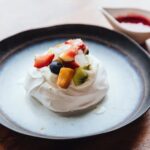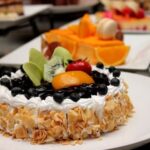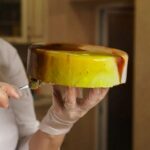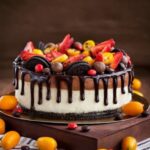Chocolate is a versatile and essential ingredient in the world of cake decorating, adding richness, flavor, and visual appeal to sweet treats. Choosing the right type of chocolate can make a significant difference in the outcome of your decorative creations. The question that often arises is: which chocolate is used for cake decorating? In this article, we will explore the various types of chocolate commonly used for cake decorations, from dark and milk chocolate to white and even vegan options.
When it comes to cake decorating, understanding the characteristics and properties of different chocolates is crucial. Dark chocolate, with its intense flavor profile and higher cocoa content, provides a rich and decadent taste to desserts. Milk chocolate, on the other hand, offers a sweeter and creamier alternative that pairs well with a wide range of flavors. White chocolate, with its milder taste and creamy texture, serves as a versatile canvas for intricate designs and decorations on cakes.
Whether you opt for compound chocolate or real chocolate for your cake decorating endeavors can also impact the final result. Each has its unique qualities and considerations when working with them in dessert design. Additionally, for those following a plant-based diet or looking for vegan alternatives, there are now various vegan chocolate options available that can be seamlessly incorporated into cake decorations to cater to diverse dietary preferences while maintaining flavor and quality.
Types of Chocolate Commonly Used for Cake Decorating
When it comes to cake decorating, the type of chocolate used plays a crucial role in determining the overall taste, texture, and appearance of the final product. There are several types of chocolate commonly used in cake decoration, each with its unique characteristics and benefits.
One of the most popular choices for cake decorating is dark chocolate. Dark chocolate has a rich and intense flavor, making it ideal for creating bold and sophisticated decorations on cakes. It also has a higher cocoa content compared to other types of chocolate, which gives it a more pronounced cocoa flavor. When working with dark chocolate for cake decorating, it is important to temper the chocolate properly to ensure a smooth finish and glossy appearance.
Another commonly used chocolate for cake decorating is milk chocolate. Milk chocolate has a sweeter taste compared to dark chocolate, making it a favorite choice for those who prefer milder flavors in their desserts.
When using milk chocolate for cake decorations, it is important to keep in mind that it has a lower cocoa content and can be more sensitive to heat. This means that proper handling and temperature control are essential when working with milk chocolate to prevent melting or discoloration.
White chocolate is another popular option for cake decorating due to its creamy texture and sweet taste. White chocolate does not contain cocoa solids like dark or milk chocolate but is made from cocoa butter, sugar, and milk solids.
It can be challenging to work with white chocolate for decorations as it has a lower melting point compared to other types of chocolate. However, when used correctly, white chocolate can add elegance and contrast to cakes with its light color and subtle flavor profiles.
In summary, choosing the right type of chocolate for cake decorating depends on personal preferences, the desired flavor profile of the final product, and technical skills in handling different types of chocolates. Whether you opt for dark, milk, or white chocolate, mastering the art of working with these chocolates will elevate your cake decorations to new heights.
| Chocolate Type | Characteristics |
|---|---|
| Dark Chocolate | Rich flavor; high cocoa content; need proper tempering |
| Milk Chocolate | Sweet taste; lower cocoa content; sensitive to heat |
| White Chocolate | Creamy texture; no cocoa solids; low melting point |
Dark Chocolate
Characteristics of Dark Chocolate
Dark chocolate has a higher cocoa content, typically around 70% or more, which gives it a more pronounced cocoa flavor. It also has less sugar than milk or white chocolate, resulting in a more intense taste. When melted, dark chocolate is thick and glossy, making it ideal for creating intricate decorations like curls, shards, or ganache drips on cakes.
Best Practices for Using Dark Chocolate in Cake Decorating
When using dark chocolate for cake decorating, it is essential to melt it gently and slowly to avoid burning or seizing. Use a double boiler or microwave in short intervals, stirring frequently until smooth. To create decorations like curls or shapes, spread melted dark chocolate on parchment paper and let it set before carefully peeling off.
For ganache drips, ensure the ganache is at the right consistency before pouring over the cake’s edge for a smooth finish. Additionally, consider tempering dark chocolate if you want a shiny finish on your decorations.
Milk Chocolate
Melting and Tempering Milk Chocolate
One key aspect of working with milk chocolate for cake decorations is melting and tempering the chocolate properly. This process ensures that the chocolate sets correctly and maintains a glossy finish. To melt milk chocolate, use a double boiler or microwave in short intervals, stirring frequently until smooth. For tempering, follow specific temperature guidelines to achieve the desired consistency for decorating cakes.
Decorating Techniques With Milk Chocolate
When using milk chocolate for cake decorations, there are various techniques you can explore to add dimension and visual appeal to your desserts. Consider piping melted milk chocolate onto parchment paper to create intricate designs that can be placed on top of cakes or cupcakes. You can also use molds to create shapes and figures out of milk chocolate, which can then be used as decorative elements on your cakes.
Combining Milk Chocolate With Other Flavors
Another way to elevate your cake decorating with milk chocolate is by combining it with complementary flavors. Consider incorporating caramel, nuts, or fruits into your milk chocolate decorations to add layers of taste and texture to your cakes. Experimenting with different flavor combinations will allow you to create unique and delicious dessert creations that will impress your guests.
White Chocolate
One of the unique qualities of white chocolate is its high cocoa butter content, which gives it a smooth and velvety consistency when melted. This makes white chocolate ideal for creating intricate designs, such as drizzles, curls, or molded shapes on cakes. However, white chocolate has a lower melting point compared to dark or milk chocolate, so it is important to handle it carefully to prevent overheating and seizing.
To effectively utilize white chocolate in cake design, it is recommended to use high-quality couverture white chocolate, which contains a higher percentage of cocoa butter and less sugar than compound coating. Couverture white chocolate provides better flavor and texture when used for decorations such as ganache, truffles, or shavings on cakes. Additionally, adding a small amount of paramount crystals or coconut oil can help stabilize the melted white chocolate for smoother application and setting on the cake.
| Characteristic | Tips |
|---|---|
| High cocoa butter content | Handle carefully to prevent overheating |
| Use high-quality couverture white chocolate | Add paramount crystals for smoother application |
Compound Chocolate vs Real Chocolate
When it comes to cake decorating, the type of chocolate used can have a significant impact on the final product. One key decision to make is whether to use compound chocolate or real chocolate. Compound chocolate, also known as coating chocolate, is made with vegetable fats instead of cocoa butter. On the other hand, real chocolate contains cocoa butter and must be tempered properly for best results in cake decorating.
Real chocolate, being made from cocoa butter, offers a rich and authentic flavor that can enhance the overall taste of your cake decorations. However, working with real chocolate can be more challenging as it requires tempering to ensure a glossy finish and proper texture. Proper tempering involves heating and cooling the chocolate to specific temperatures to align the cocoa butter crystals for smooth and shiny results in cake decorating.
Compound chocolate, while easier to work with due to its stability at room temperature, may lack some of the depth and complexity found in real chocolate. It is a good option for beginners or when you need a quick fix for cake decorations without the need for tempering. However, keep in mind that compound chocolate may not deliver the same quality or flavor profile as real chocolate in cake decorating projects that require top-notch results.
Vegan Chocolate Options for Cake Decorating
When it comes to cake decorating, choosing the right chocolate is essential for achieving delicious and visually appealing results. For those who follow a vegan lifestyle or have dietary restrictions, finding suitable chocolate options can be a challenge. Fortunately, there are several vegan chocolate choices available that work perfectly for cake decorating. Here are some recommendations for those looking for plant-based alternatives:
- Dark Chocolate: Dark chocolate is naturally dairy-free and can be an excellent choice for vegan cake decorations. Look for high-quality dark chocolate with a cocoa content of at least 70% to ensure a rich flavor and smooth texture.
- Vegan White Chocolate: While traditional white chocolate contains dairy, there are now vegan-friendly white chocolate alternatives made from ingredients like coconut milk or soy milk. These products can be used to create stunning decorations with a creamy and sweet flavor.
- Vegan Milk Chocolate: For those who prefer the taste of milk chocolate, there are also vegan versions available on the market. These chocolates are often made with plant-based milks such as almond or oat milk, providing a similar taste and texture to traditional milk chocolate.
Incorporating vegan chocolate options into your cake decorating repertoire not only allows you to accommodate various dietary needs but also opens up new creative possibilities. Experimenting with different types of vegan chocolates can inspire unique designs and flavor combinations that will impress your guests. Whether you choose dark, white, or milk vegan chocolate, selecting high-quality products is key to achieving professional-looking results in your cake decorations.
Tips and Tricks for Using Chocolate in Cake Decorating
Working with chocolate in cake decorating can be both exciting and challenging. Whether you are a beginner or a seasoned baker, mastering the art of using chocolate for decorations can elevate your cakes to a whole new level. Choosing the right type of chocolate is crucial for achieving the desired results, as different varieties have distinct characteristics that can impact the final look and taste of your creation.
One of the most important tips when working with chocolate for cake decorating is to temper it properly. Tempering ensures that the chocolate has a smooth texture and shiny finish once it sets. This process involves melting the chocolate, then cooling it down while stirring continuously until it reaches the ideal temperature for forming decorations. Properly tempered chocolate will have a crisp snap when broken and will hold its shape well when used for decorating.
Another key technique when using chocolate for cake decorations is piping. Piping allows you to create intricate designs, patterns, and even lettering on your cakes. To pipe with chocolate, melt it to a smooth consistency, transfer it to a piping bag fitted with a small tip, and carefully pipe your desired design onto parchment paper or directly onto your cake.
It’s essential to work quickly but carefully when piping with chocolate, as it can harden fast at room temperature. Practice makes perfect when it comes to piping with chocolate, so don’t get discouraged if your first attempts aren’t flawless. Keep experimenting and refining your skills to achieve stunning results in cake decorating.
Conclusion
In conclusion, the type of chocolate used in cake decorating plays a vital role in the overall look and taste of the final product. Whether you opt for dark, milk, white, or even vegan chocolate, each variety brings its own unique characteristics to the table which can elevate your cake design to new heights. Understanding the differences between compound and real chocolate is also crucial in ensuring that your decorations turn out just as you envisioned.
Choosing the right chocolate for your cake decorating endeavors can make a significant difference in the outcome of your desserts. Dark chocolate is rich and intense, perfect for adding depth and sophistication to your designs.
Milk chocolate offers a creamy sweetness that appeals to many palates, while white chocolate provides a blank canvas for creativity with its smooth texture and subtle flavor. For those following a plant-based diet or looking for vegan options, there are now a plethora of chocolatiers creating delicious vegan chocolates that are perfect for cake decorating.
In the world of cake decorating, the possibilities are truly endless when it comes to utilizing chocolate as a medium for creating stunning designs. By experimenting with different types of chocolate and techniques, you can unlock endless opportunities to express your creativity and wow your guests with beautifully crafted desserts. So next time you’re planning on decorating a cake, remember to carefully consider which chocolate is best suited for your design concept and let your imagination run wild.
Frequently Asked Questions
What Chocolate Is Best for Cake Decoration?
The best chocolate for cake decoration is typically high-quality couverture chocolate, which contains a higher percentage of cocoa butter compared to regular chocolate. This type of chocolate melts smoothly and can be easily tempered for creating decorations like curls, shavings, or ganache.
What Kind of Chocolate Is Used for Chocolate Art?
When it comes to chocolate art, many chocolatiers prefer using tempered dark chocolate due to its intense flavor and versatility. Dark chocolate with a cocoa content of at least 70% is often used for molding intricate designs or creating delicate sculptures. Its rich flavor profile adds depth to the artwork.
Which Chocolate Is Used for Making Cake?
For making cakes, it’s important to use good quality baking chocolate that complements the overall flavor profile of the cake. Semisweet or bittersweet chocolate is commonly used in cake recipes because they provide a nice balance of sweetness and richness. Cocoa powder can also be added to enhance the chocolaty taste in cakes.

Welcome to my blog about home and family. This blog is a place where I will share my thoughts, ideas, and experiences related to these important topics. I am a stay-at-home mom with two young children. I hope you enjoy reading it! and may find some helpful tips and ideas that will make your home and family life even better!





